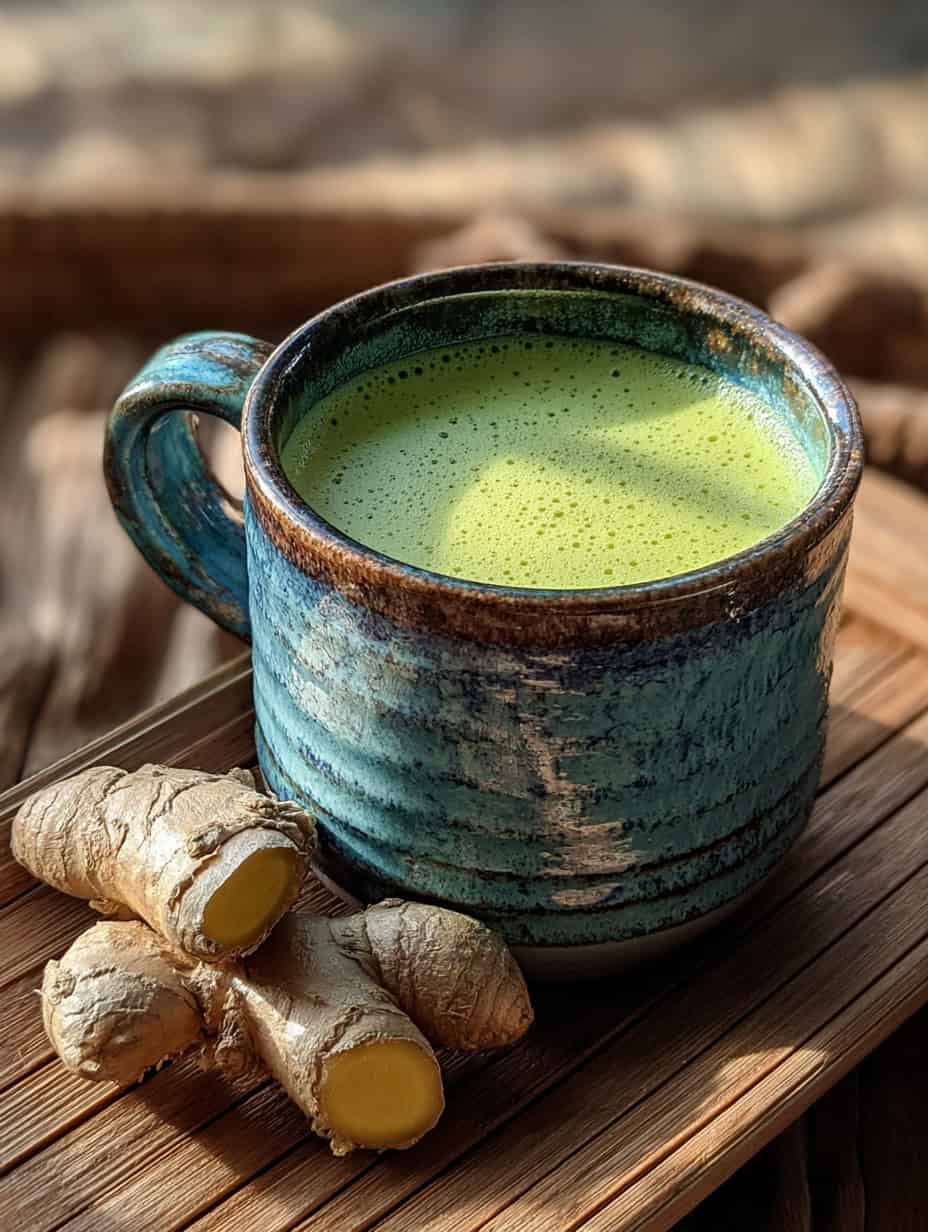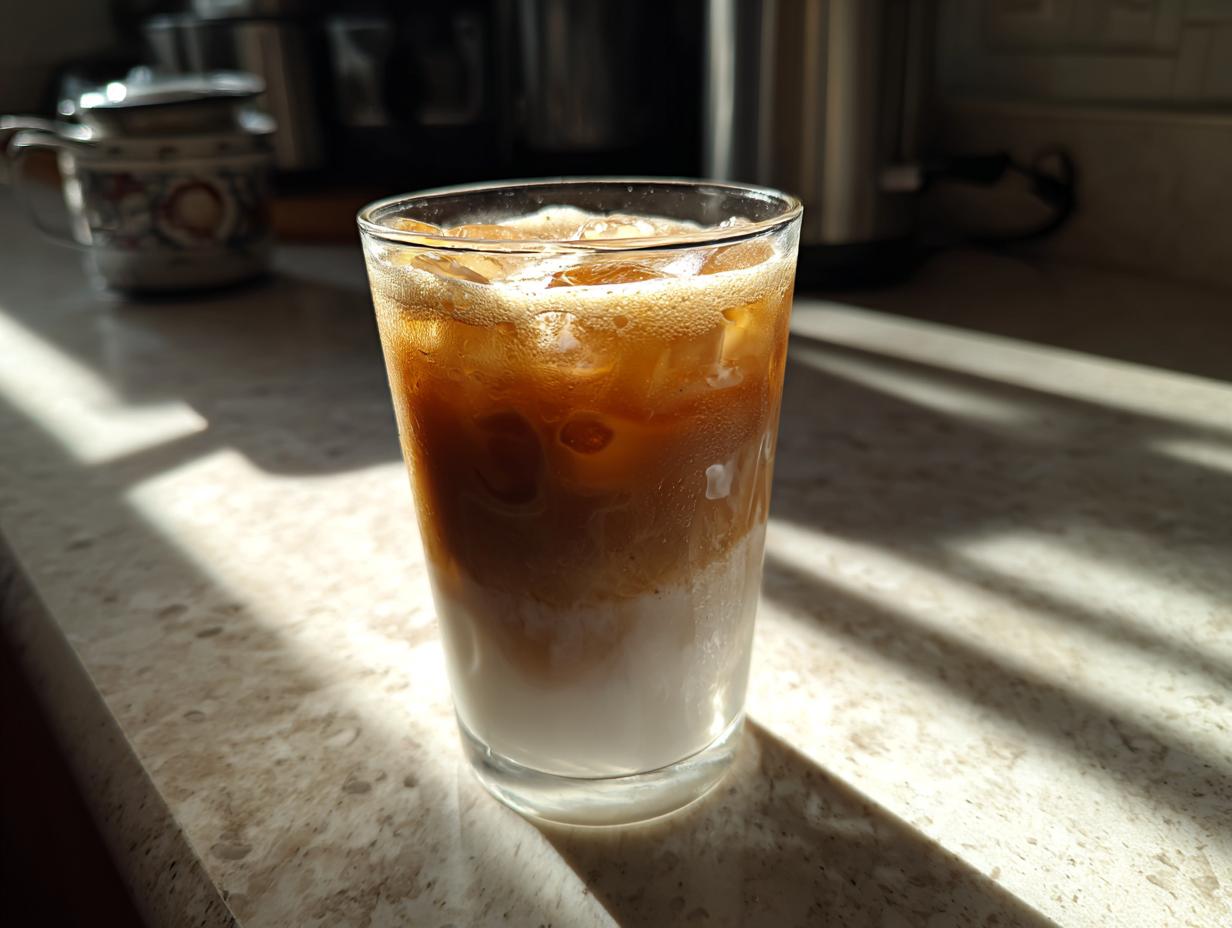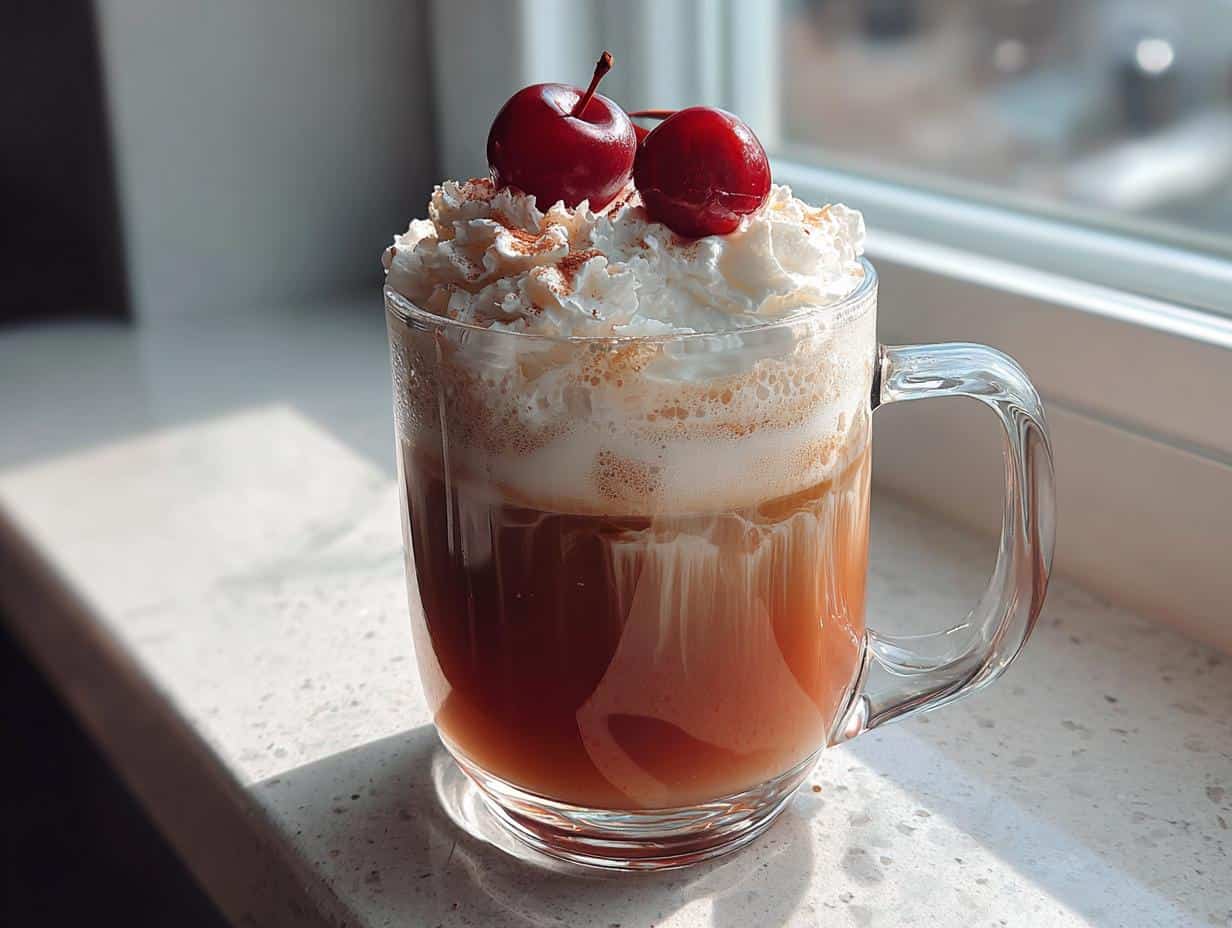Introduction
The Japanese Mounjaro Recipe is more than just a trendy wellness drink—it’s a centuries-old Japanese elixir designed to restore digestive health, boost energy, and detox the body naturally. If you’re tired of artificial supplements or quick fixes, this drink offers a clean, nutrient-rich alternative. Combining matcha, umeboshi plum paste, ginger, and kombu, this powerful tonic delivers a deeply nourishing experience that supports your entire system.
What makes the Japanese Mounjaro Recipe so appealing is its balance of savory, sour, and slightly sweet flavors—all coming from ingredients with ancient medicinal uses. From your first sip, you’ll notice not only the flavor complexity but also the instant soothing effect it has on your stomach and energy levels.
Looking for inspiration? Try our Lemon Balm Recipe for Weight Loss to complement your wellness journey with this revitalizing Japanese recipe.
Table of Contents
What is the Japanese Mounjaro Recipe?
Understanding the Origins of Japanese Mounjaro
The Japanese Mounjaro Recipe finds its roots in traditional Japanese macrobiotic and detox practices. While not as globally known as matcha or miso, this recipe has long been favored in Japan for its ability to restore internal balance and eliminate sluggishness. The term “Mounjaro” is often used today to describe this energizing concoction that relies heavily on nature-based ingredients with specific healing purposes.
Unlike regular teas or green drinks, the Japanese Mounjaro Recipe is deeply umami-rich, integrating fermented and mineral-heavy components that offer digestive harmony and mental clarity. Ancient Japanese wellness beliefs center around aligning the gut, energy flow, and blood alkalinity—and this recipe reflects that philosophy.
What Makes Mounjaro Unique from Other Herbal Blends?
When comparing the Japanese Mounjaro Recipe to typical herbal infusions or teas, its uniqueness becomes crystal clear. Most herbal drinks rely on dried herbs or simple fruit infusions. In contrast, Mounjaro features kombu (kelp), umeboshi plum paste, matcha, and fresh ginger—each offering distinct health-boosting benefits.
Here’s what makes this blend different:
- It’s savory, not sweet.
- It includes umami-rich sea minerals.
- It’s packed with probiotics and antioxidants.
- It actively supports digestion, detoxification, and energy balance.
This is not your average calming tea. The Japanese Mounjaro Recipe is made for action, clarity, and gut strength. It’s ideal for those who want a natural, non-caffeinated drink that revitalizes from within.
Health Benefits of the Japanese Mounjaro Recipe
How the Japanese Mounjaro Recipe Supports Digestive Wellness
A key reason people turn to the Japanese Mounjaro Recipe is its exceptional digestive support. Each ingredient serves a critical function in promoting a healthy gut environment:
- Umeboshi plum paste, a fermented Japanese staple, helps balance stomach acidity and improves digestion.
- Fresh ginger acts as a digestive stimulant, reducing bloating, gas, and nausea.
- Kombu is rich in iodine, magnesium, and trace minerals that feed your gut microbiome.
When combined, these ingredients create a synergistic effect that cleanses the gut, enhances nutrient absorption, and reduces inflammation. The Japanese Mounjaro Recipe is especially effective when consumed on an empty stomach in the morning or mid-afternoon.
Looking for a digestive reset? Discover great ideas like our Pink Salt Weight Loss Recipe—another potent cleansing option.
Detox, Energy & Immune-Boosting Properties
The Japanese Mounjaro Recipe isn’t just about digestion. It’s also a natural detox and energy-enhancing tonic. Here’s why:
- Matcha is packed with L-theanine and catechins, delivering clean, focused energy without the crash of coffee.
- Kombu helps detoxify the body by binding to heavy metals and supporting liver function.
- Umeboshi helps alkalize the blood, fight fatigue, and support liver health.
- Raw honey (optional) offers mild immune support thanks to its natural antibacterial properties.
Here’s a quick breakdown of benefits:
| Ingredient | Core Function | Health Benefit |
|---|---|---|
| Matcha | Antioxidants + L-theanine | Mental clarity + energy |
| Umeboshi Plum Paste | Fermentation + alkalinity | Gut balance + fatigue relief |
| Fresh Ginger | Anti-inflammatory + stimulant | Bloating relief + immune support |
| Kombu | Sea minerals + detox | Thyroid support + gut detox |
| Raw Honey (optional) | Natural antimicrobial | Sore throat + immune system boost |
With this combo, the Japanese Mounjaro Recipe becomes a daily ritual for wellness warriors who want sustained energy, digestive clarity, and immunity—all in one warm drink.
Don’t miss our Udon Noodle Soup Recipe for a cozy, gut-friendly meal to go with your Mounjaro drink.
Ingredients Needed for Japanese Mounjaro

Key Ingredients and Their Holistic Benefits
The magic of the Japanese Mounjaro Recipe lies in its simplicity. Each ingredient is chosen not just for its flavor, but for its ability to support your body’s natural balance. Here’s what you need to craft this powerful elixir:
- 1 teaspoon premium matcha powder
- Why it matters: Matcha is packed with chlorophyll, L-theanine, and EGCG (epigallocatechin gallate), providing clean energy, mental clarity, and antioxidant protection. It gently boosts metabolism and detoxifies the body.
- 1 tablespoon umeboshi plum paste
- Why it matters: This fermented Japanese plum supports the liver, neutralizes acidity, and restores gut health. It’s especially valuable for its alkaline effect on the body and ability to counteract fatigue and nausea.
- 1 teaspoon freshly grated ginger
- Why it matters: Ginger stimulates digestion, reduces inflammation, and enhances nutrient absorption. It adds a warming, spicy edge that balances the sourness of the umeboshi.
- 1 small strip of kombu (2 inches)
- Why it matters: Kombu is a sea vegetable rich in iodine, calcium, magnesium, and umami flavor. When soaked in warm water, it releases minerals that aid detox and thyroid function.
- 1 cup hot water (about 175°F / 80°C)
- Why it matters: Hot (not boiling) water helps extract nutrients without destroying sensitive compounds, especially in matcha and kombu.
- 1 teaspoon raw honey (optional)
- Why it matters: While optional, honey can mellow the sourness of umeboshi and deliver antibacterial and throat-soothing properties.
This entire mix makes the Japanese Mounjaro Recipe a synergistic blend, offering not just flavor, but also a full-body refresh. Each element contributes to the whole, supporting digestion, immunity, and detox pathways naturally.
Discover great ideas like our Thai Green Curry Tofu Recipe to complement your wellness routine.
Where to Source Authentic Mounjaro Ingredients
To get the full effect of the Japanese Mounjaro Recipe, quality matters. Here’s where and how to find the right ingredients:
- Matcha Powder: Look for ceremonial-grade, organic matcha sourced from Japan (Uji or Nishio regions are highly regarded).
- Umeboshi Plum Paste: Found at Japanese or Asian grocery stores, or online from reputable organic brands.
- Kombu: Choose dried, unseasoned kombu with no additives. Hokkaido kombu is a premium variety.
- Raw Honey: Use local or manuka honey for added benefits, but make sure it’s raw and unfiltered.
| Ingredient | Where to Buy | What to Look For |
|---|---|---|
| Matcha | Health food stores, online | Ceremonial-grade, vibrant green |
| Umeboshi Paste | Asian markets, organic shops | Organic, no added sugars or dyes |
| Kombu | Japanese grocery, online | Dried strips, no seasoning |
| Ginger | Local grocery or farmer’s market | Fresh, firm, no wrinkles |
| Raw Honey | Local co-ops, online | Raw, unfiltered, organic |
Using the wrong ingredients—like culinary matcha instead of ceremonial, or pickled plums instead of true umeboshi—can dull the effects and even offset the health benefits.
Check out our Easy Acai Bowl Recipe for another nutrient-dense, refreshing recipe.
How to Make Japanese Mounjaro Step-by-Step
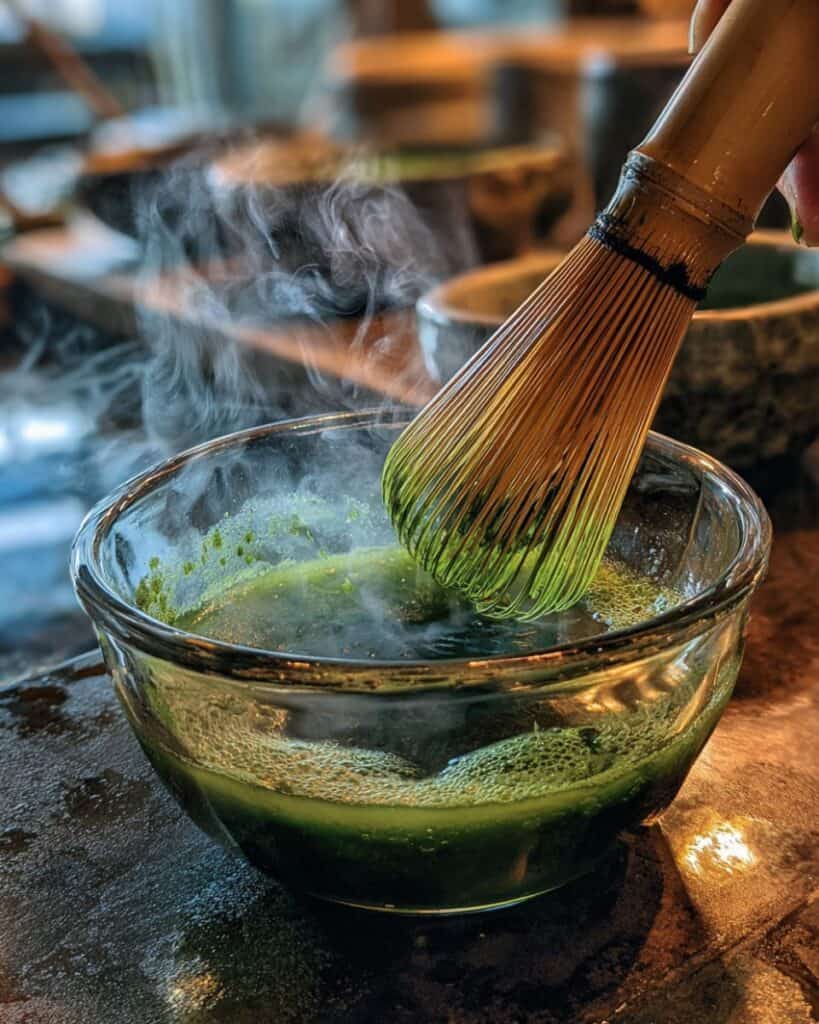
Traditional Preparation Method with Kombu and Matcha
Making the Japanese Mounjaro Recipe is a simple process that respects the integrity of its natural ingredients. The goal is to gently infuse the kombu, fully blend the paste and powders, and avoid overheating the matcha. Here’s the exact step-by-step guide to prepare it at home:
Ingredients Recap:
- 1 small strip (2 inches) of dried kombu
- 1 cup hot water (about 175°F / 80°C)
- 1 teaspoon premium matcha powder
- 1 tablespoon umeboshi plum paste
- 1 teaspoon freshly grated ginger
- 1 teaspoon raw honey (optional)
Directions:
- Soak the Kombu Strip
Start by soaking the kombu strip in hot water (not boiling) for 3 minutes. This extracts valuable marine minerals without overcooking the kelp. Discard the kombu after soaking, leaving behind a nutrient-rich base. - Whisk in the Matcha Powder
Using a bamboo whisk or small electric frother, mix the matcha into the warm infused water. Whisk in a “W” motion until smooth and frothy. This ensures no clumps and activates the matcha’s chlorophyll compounds. - Add Umeboshi and Ginger
Stir in the umeboshi plum paste and freshly grated ginger. Blend until fully dissolved and uniform. The ginger adds heat while the umeboshi contributes tang and gut-supporting probiotics. - Optional: Stir in Raw Honey
If you prefer a milder, slightly sweet taste, mix in a teaspoon of raw honey. This balances the sourness of the umeboshi and adds antimicrobial benefits. - Sip Slowly and Mindfully
Pour your finished Japanese Mounjaro Recipe into a small teacup or mug and sip slowly. It’s best enjoyed warm on an empty stomach or as a midday reset drink.
Don’t miss our Blue Salt Trick Recipe if you’re looking to explore other Japanese-inspired detox drinks.
Modern Twists: Variations with Honey or Other Add-ons
While the traditional Japanese Mounjaro Recipe is minimalist, there are ways to adapt it for modern preferences without losing its core benefits. Here are a few safe and beneficial variations:
| Add-on Ingredient | Why Use It | Health Impact |
|---|---|---|
| Manuka Honey | Natural antibacterial sweetener | Soothes throat, boosts immunity |
| Lemon Juice | Vitamin C boost | Enhances detox & flavor brightness |
| Coconut Water | Replace hot water | Adds electrolytes and hydration |
| Chia Seeds | Stir in before sipping | Adds fiber and omega-3 fatty acids |
| Cinnamon | Sprinkle on top | Balances blood sugar levels |
Tip: Avoid using boiling water. Boiling destroys matcha’s L-theanine and can make the flavor bitter. Always use water around 175°F / 80°C.
These variations maintain the spirit of the Japanese Mounjaro Recipe while adjusting it for seasonal needs, personal health goals, or flavor preferences.
Natural Ways to Customize Mounjaro for Health Goals
Weight Loss, Gut Health, and Anti-inflammatory Tweaks
The beauty of the Japanese Mounjaro Recipe lies in its flexibility. While the traditional version is powerful on its own, you can tailor the drink to better support your personal health goals—especially if you’re focused on weight loss, gut health, or reducing inflammation.
1. For Weight Loss
To make the Japanese Mounjaro Recipe even more effective for fat metabolism:
- Add fresh lemon juice: Enhances detoxification and improves bile flow.
- Use Ceylon cinnamon: Supports blood sugar stability and reduces cravings.
- Substitute raw honey with stevia (if needed): Avoids added sugars while maintaining slight sweetness.
These tweaks increase the fat-burning potential while preserving the drink’s core cleansing effect.
2. For Gut Health
To supercharge the gut-healing properties of your Japanese Mounjaro:
- Add a teaspoon of apple cider vinegar: This boosts the probiotic effect and balances stomach acid.
- Include chia seeds: Stir in a half teaspoon for extra prebiotic fiber.
The fermentation from umeboshi and the minerals from kombu already do a lot of gut work—these additions simply amplify it.
3. For Inflammation
To tailor your Japanese Mounjaro Recipe for anti-inflammatory benefits:
- Add turmeric and a pinch of black pepper: This classic duo reduces inflammation and improves nutrient absorption.
- Replace regular ginger with turmeric-ginger paste if available.
This anti-inflammatory version is perfect for people suffering from chronic fatigue, joint pain, or skin flare-ups.
Check out our 15-Minute Sesame Ginger Noodles Recipe—another gut-friendly, anti-inflammatory meal option.
When and How Often to Drink Japanese Mounjaro
For best results, drink the Japanese Mounjaro Recipe:
- First thing in the morning on an empty stomach to activate digestion.
- Mid-afternoon to avoid energy crashes and sugar cravings.
- Up to 2 times daily, especially during detox or wellness resets.
This drink isn’t meant to be overused—it’s a concentrated tonic, not a replacement for hydration. Aim for consistency over volume. One small cup daily is enough to feel a difference within a week.
| Time to Drink | Benefit |
|---|---|
| Morning (fasted) | Activates metabolism and digestion |
| Mid-afternoon | Boosts energy and curbs cravings |
| Before yoga/meditation | Enhances focus and inner balance |
Remember: Quality of ingredients matters more than quantity. Always source fresh, organic components to get the full benefit of your Japanese Mounjaro Recipe.
Japanese vs Brazilian Mounjaro: Key Differences
Ingredient Comparison: What Are the Three in Brazilian Mounjaro?
While the Japanese Mounjaro Recipe is a traditional blend rooted in macrobiotic and detox philosophies, the Brazilian Mounjaro—often popularized in health circles—has emerged as a simplified, tropical variant with distinct differences in ingredients and purpose.
Here’s a direct comparison of both versions:
| Feature | Japanese Mounjaro Recipe | Brazilian Mounjaro |
|---|---|---|
| Core Ingredients | Matcha, Umeboshi, Ginger, Kombu | Coconut Water, Lime Juice, Chia Seeds |
| Purpose | Detox, Digestion, Energy | Hydration, Weight Loss Support |
| Flavor Profile | Savory, Tangy, Earthy | Citrusy, Sweet, Refreshing |
| Cultural Roots | Japan, Macrobiotic Tradition | Brazil, Amazonian Detox Tradition |
The three ingredients in Brazilian Mounjaro that are commonly promoted in health circles include:
- Coconut Water – Hydrating and full of electrolytes, helps flush toxins.
- Lime Juice – Alkalizing and vitamin C-rich.
- Chia Seeds – Packed with omega-3s and soluble fiber.
While both recipes aim for detoxification and gut health, their mechanisms and cultural backbones differ greatly. The Japanese Mounjaro Recipe relies more on fermentation and mineralization through kombu and umeboshi, while the Brazilian version emphasizes hydration and fiber content.
If you’re choosing between the two, your goals should guide you:
- Go Japanese for metabolism, deep detox, and digestive strength.
- Go Brazilian for light hydration and fiber-rich weight balance.
Don’t miss our Marry Me Pasta Recipe for a romantic, energy-packed meal to pair with your wellness drink.
Cultural Origins and Nutritional Comparison
The Japanese Mounjaro Recipe is influenced by Zen philosophy and traditional medicine, which promotes balance between acidic and alkaline foods. It’s a more intense wellness experience, often used during seasonal resets or healing periods.
Brazilian Mounjaro, by contrast, has more tropical and fitness-focused origins. It’s often used in post-workout recovery routines or as a morning drink to kickstart digestion without caffeine.
Here’s a quick nutritional glance:
| Nutrient Focus | Japanese Mounjaro | Brazilian Mounjaro |
|---|---|---|
| Iodine & Minerals | From kombu | Minimal |
| Fermented Probiotics | From umeboshi | None |
| Antioxidants | High from matcha | Moderate from lime |
| Fiber | Low | High from chia seeds |
| Hydration | Moderate | High from coconut water |
Ultimately, the Japanese Mounjaro Recipe stands out for its depth of health benefits, especially in restoring internal balance, supporting digestion, and offering clean energy through real nutrients—not just hydration or fiber.
FAQs on Japanese Mounjaro Recipe
How do you make Japanese Mounjaro?
To make the Japanese Mounjaro Recipe, start by soaking a strip of kombu in a cup of hot water (not boiling) for about 3 minutes. Remove the kombu and whisk in premium matcha powder until smooth. Then, stir in umeboshi plum paste and freshly grated ginger until fully dissolved. If desired, you can add a teaspoon of raw honey for sweetness. The result is a deeply nourishing tonic that energizes the body and supports digestion.
For a full walkthrough, refer to Part 4 above.
What is the natural way to make Mounjaro?
The natural way to make the Japanese Mounjaro Recipe is by using clean, whole-food ingredients without any additives. Use organic kombu, ceremonial-grade matcha, natural umeboshi plum paste, and fresh ginger. These ingredients should be unprocessed and free from artificial preservatives. The water should be hot, but not boiling, to preserve the sensitive nutrients in matcha and kombu. Avoid shortcuts like powdered ginger or sweetened matcha blends if you’re aiming for the most natural and beneficial version.
What are the ingredients in Mounjaro?
The core ingredients in the Japanese Mounjaro Recipe include:
- Matcha powder – for energy and antioxidant support
- Umeboshi plum paste – for gut health and alkalinity
- Freshly grated ginger – for digestion and inflammation
- Kombu (dried kelp) – for minerals and thyroid support
- Hot water (175°F/80°C) – to infuse and blend
- Raw honey (optional) – for sweetness and immune benefits
Each ingredient has a purpose, working together to detox the body, fuel metabolism, and ease digestive issues.
What are the three ingredients in Brazilian Mounjaro?
The Brazilian Mounjaro is a simplified, tropical version that uses:
- Coconut Water – for hydration and electrolytes
- Lime Juice – for alkalinity and vitamin C
- Chia Seeds – for fiber and omega-3s
Unlike the Japanese Mounjaro Recipe, the Brazilian version is lighter and more focused on hydration and weight loss support. It’s also easier to make on the go but lacks the fermented and mineral-rich depth found in the Japanese preparation.
Don’t miss our Cinnamon Tea Recipe—another great natural drink to add to your wellness toolkit.
Common Mistakes to Avoid While Making Mounjaro
Overheating Matcha or Kombu: What You Lose
One of the most frequent mistakes when preparing the Japanese Mounjaro Recipe is using water that’s too hot. Boiling water (above 185°F / 85°C) can destroy matcha’s L-theanine and antioxidants, leading to a bitter taste and reduced nutritional value. Likewise, overheating kombu can release excess iodine and a slimy texture that affects both the flavor and function of the drink.
What to do instead:
- Keep your water temperature around 175°F / 80°C.
- Soak kombu gently for 3 minutes, then discard.
- Whisk matcha after removing kombu to retain its integrity.
Skipping Quality Umeboshi: Why It Matters
Another common error is replacing real umeboshi plum paste with flavored alternatives or pickled plums that lack fermentation. Authentic umeboshi is fermented, probiotic-rich, and deeply alkaline—exactly what makes the Japanese Mounjaro Recipe so effective for digestion and detox.
If you’re using a low-quality substitute, you’re likely losing out on:
- The alkalizing benefits that balance stomach acid
- The probiotic properties that support gut flora
- The umami punch that makes the drink uniquely satisfying
Avoid cheap alternatives found in general grocery stores—look for umeboshi in specialty Asian or macrobiotic shops and always check the ingredient label for authenticity.
Pro tip: Choose umeboshi that’s traditionally made, with only plums, sea salt, and shiso leaves.
Looking for more traditional blends? Discover our Kimchi Ramen Recipe for a spicy, fermented gut-friendly dish.
Other mistakes to avoid:
- Using culinary matcha instead of ceremonial-grade: The quality difference affects both taste and antioxidant levels.
- Blending ingredients cold: Warm water is essential to activate matcha and dissolve umeboshi properly.
- Skipping the ginger: This small addition is crucial for enhancing circulation and digestion.
Avoiding these simple mistakes ensures your Japanese Mounjaro Recipe is not only delicious but fully effective.
Serving, Storing & Enjoying Japanese Mounjaro
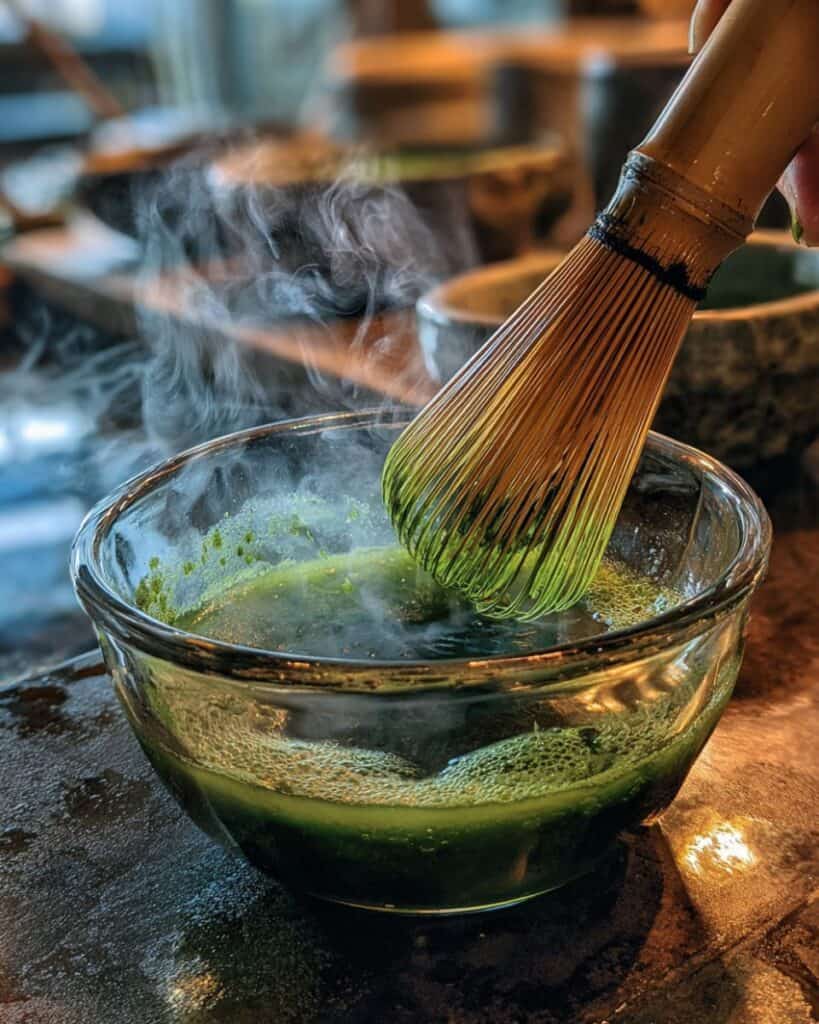
Best Practices for Freshness and Storage
The Japanese Mounjaro Recipe is most beneficial—and flavorful—when consumed fresh. Because it contains matcha, fresh ginger, and umeboshi paste, the delicate balance of enzymes and active compounds can degrade over time if not stored correctly.
Here’s how to store it if you must prep ahead:
- Refrigerate in a sealed glass container (like a mason jar) for up to 24 hours.
- Shake or whisk before drinking to re-blend any settled ingredients.
- Do not reheat in a microwave, as it can reduce matcha’s efficacy. Instead, gently warm it by placing your jar in a hot water bath.
Ideally, the Japanese Mounjaro Recipe should be made fresh each morning, especially if you’re using it for detox or digestive reset purposes.
How to Sip for Maximum Absorption and Flavor
To make the most of every sip, follow these simple practices:
- Drink slowly: Take small sips, allowing the enzymes and minerals to start working in your mouth before digestion even begins.
- Use a ceramic or glass cup: Avoid metal, as it may react with acidic umeboshi and affect taste.
- Pair it with silence or calm: Drinking the Japanese Mounjaro Recipe mindfully, much like a tea ceremony, allows your body to absorb more benefits and create a healing ritual.
| Tip | Why It Matters |
|---|---|
| Sip slowly | Enhances digestion via salivary enzymes |
| Avoid metal containers | Prevents reaction with fermented umeboshi |
| Drink mindfully | Boosts stress relief and absorption |
| Consume on an empty stomach | Improves detox and metabolic benefits |
For enhanced daily energy, combine the Japanese Mounjaro Recipe with a light, gut-friendly breakfast like miso soup or a veggie bowl. If you’re using it as a pre-workout, consume 30 minutes before light exercise or yoga.
Don’t miss our Weeknight Tofu Stir Fry Recipe for a simple, clean meal to pair with your morning elixir.
Conclusion
The Japanese Mounjaro Recipe is more than a drink—it’s a wellness ritual rooted in centuries of Japanese tradition. With ingredients like matcha, umeboshi, kombu, and ginger, this potent elixir helps improve digestion, balance gut bacteria, support detox, and offer calm, steady energy.
Whether you’re using it for a morning cleanse, an afternoon energy lift, or as part of a larger wellness journey, the Japanese Mounjaro Recipe is a natural and powerful addition to your routine.
Looking for more gut-friendly, energizing recipes? Check out our Strawberry Banana Chia Seed Smoothie—perfect to pair with Mounjaro on warm mornings.
for more recipe: Facebook, Pinterest
Print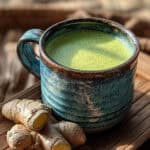
Japanese Mounjaro Recipe
- Total Time: 5 min
- Yield: 1 Serving 1x
- Diet: Gluten Free
Description
Ingredients
- 1 teaspoon premium matcha powder
- 1 tablespoon umeboshi plum paste
- 1 teaspoon freshly grated ginger
- 1 small strip about 2 inches of dried kombu (kelp)
- 1 cup hot water not boiling, about 175°F/80°C
- 1 teaspoon raw honey optional, for added sweetness
Instructions
- Steep a kombu strip in 1 cup of hot water for 3 minutes to draw out its minerals, then discard the kombu.
- Whisk matcha powder into the warm infusion until it’s smooth and frothy.
- Mix in umeboshi plum paste and grated ginger until well incorporated.
- Sweeten with honey if desired.
- Sip slowly and enjoy the bold, nourishing flavors.
Notes
- For a stronger matcha flavor, use 1.5 teaspoons of matcha powder.
- No umeboshi paste? Mash 1–2 whole umeboshi plums instead.
- Add a squeeze of lemon for a zesty kick and extra vitamin C.
- Use freshly grated ginger for the best flavor and health boost.
- Experiment with different honeys—like manuka—for added wellness benefits.
- Prep Time: 5 min
- Category: Wellness Drink
- Method: Whisking & Soaking
- Cuisine: American, Japanese, Japanese-Inspired
Nutrition
- Serving Size: 1 Cup
- Calories: 25 Kcal
- Sugar: 6g
- Sodium: 120mg
- Fat: 0g
- Saturated Fat: 0g
- Unsaturated Fat: 0g
- Trans Fat: 0g
- Carbohydrates: 6g
- Fiber: 1.2g
- Protein: 0.5g
- Cholesterol: 0mg
